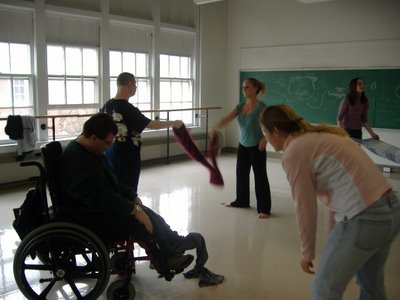Dance Therapy 101: A crash course as experienced at Ohio University
It’s necessary to understand that different therapy sessions target different objectives. For example, the primary area of focus for the weekly dance therapy group with ATCO participants is to increase physical functioning. My co-facilitator, Haley, and I find that they – like many adults – typically do not have the opportunities to use their bodies freely and to their full potential. As a result of this attitude toward movement (viewing it in a purely functional light, therefore minimizing its possibilities), the ATCO participants have developed a limited range of movement patterns. Because our primary objective is to increase physical functioning, our class tends to be run almost like a creative movement class, focusing on the exploration of using the body in different ways.
Inside the dancer’s studio
A typical 35-minute dance/creative movement session with ATCO participants might follow a schedule like this:
11:10 a.m. – ATCO participants (usually six) arrive and remove their shoes, a ritual that helps them shift into a “movement” mindset. They are joined by about six volunteers, college students who partner with the ATCO participants in all activities. This one-to-one (participant-to-volunteer) ratio is important because the participants having varying levels of mobility and activity comprehension. Volunteers help the participants tailor movement activities to the level that will be most beneficial to them.
11:15 a.m. – We begin warm-up activities, such as moving different body parts to music. This helps participants begin to acknowledge movement in places they might not have previously considered, such as their shoulders or knees.
(I've included several pictures in this entry to help illustrate different activities I describe. I took all of them during a recent creative movement session.)

In the pictures below, we used scarves as a prop to encourage movement. Their floating quality encourages large arced arm movements and tossing movements (to throw them up and catch them as they floated down). Participants focused on upper body movement in this activity.
Here, (left to right) ATCO participants Jason and Rex, and volunteers Haley, Sjannake and Ashleigh explore the movement possibilities of the scarves.

Volunteer Ashley and ATCO participant Marcia begin to warm up to the idea of holding on to the scarf while simlutaneously doing other movement.

It’s important to remember that this is only one type of dance therapy session. Many other types, which are more specialized and likely to address emotional and cognitive issues, are led by professionals certified by the American Dance Therapy Association. These cognitive and emotional focuses – as well as the physical focus that the ATCO group takes – can be useful to all populations of people.

0 Comments:
Post a Comment
<< Home